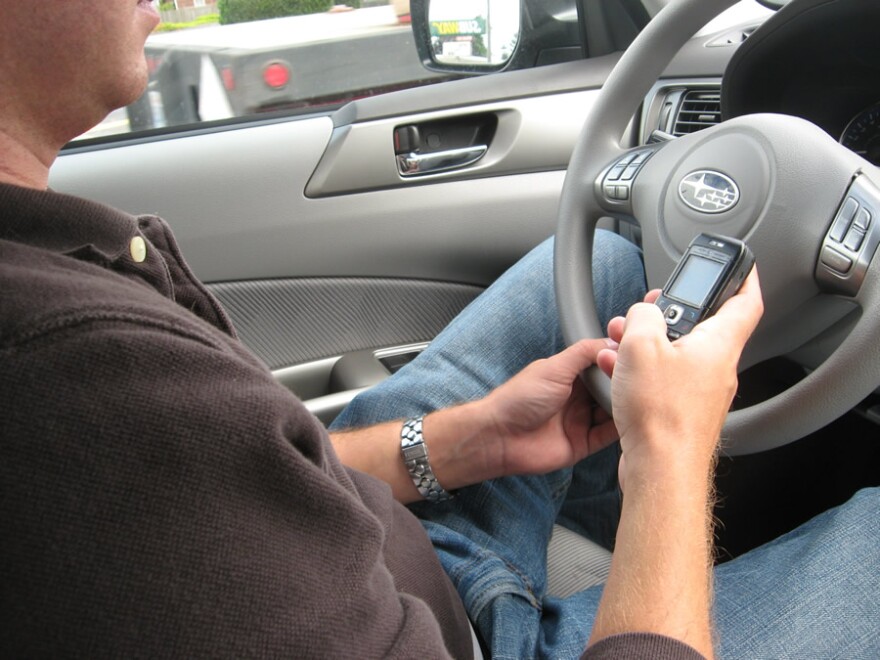Texas lawmakers will try again this Legislative session to outlaw texting and driving.
Lawmakers voted to criminalize texting while driving statewide in 2011, but Governor Rick Perry vetoed that bill before it became law.
25 cities in Texas already have texting and driving bans. Austin and San Antonio are among them. But last month at the Capitol, lawmakers and families of victims of texting and driving crashes urged a statewide ban – just like 39 other states.
“Personal responsibility is just not enough anymore. We’ve tried that and we continue to lose too many lives,” said Jennifer Smith, the president of the Distraction Advocate Network. She lost her mother in 2008 in an accident where another driver was on a cell phone. “With education and awareness, partnered with laws and enforcement, it equals prevention of crashes and saved lives.”
But is that equation accurate? First, a little education.
Christine Yager is a researcher at the Texas Transportation Institute. A few years ago, she dida studywhere “we had participants drive an instrumented vehicle on a closed course."
That vehicle had this light that turned on at random intervals.
“And we instructed the driver to press a response button if they noticed that light was on," Yager said. Response times were one or two seconds when they were just driving. “But when they were either reading or writing a text message, it took them about 3 to 4 seconds to respond.”
At 60 miles an hour you can go a long way in those couple extra seconds. So there’s no question that texting while driving isn’t safe. What’s less clear is whether texting bans do anything to make things safer.
A couple years ago, a group called the Highway Loss Data Institute (HLDI) did this studylooking at crash rates in four states: California, Louisiana, Minnesota and Washington. And they looked at the rate of car crashes in those states before and after they banned texting and driving.
“The result was that not only did crash rates not go down in those states after the ban was implemented – but in three of the four states, crashes actually went up slightly," said Russ Rader, a spokesman for the Insurance Institute for Highway Safety, an affiliate of the HLDI.
The study did not look at why, it only found that after the ban started, the number of crashes stayed the same or went up. And crashes went up in all four states among young drivers.
“And those are also the drivers who are most likely to text,” said Rader.
But the law is supposed to change people’s behavior and make them stop texting. So what happened? Rader says maybe the ban did change behavior. Just not the way it was supposed to. Before the ban, he said “many drivers may have simply been texting by putting the phone up on the steering wheel so they didn’t take their eyes off the road as much as they might otherwise, if they were trying to look down to text.”
But after the ban took effect, Rader theorizes, "in order to conceal the fact that they were texting from police officers – they may have been moving the phone down below window level.”
Which would make response time even longer.
“I could see how that could become an issue if there was a texting ban, people trying to hold their phones lower which makes them lower their eyes from the road even more, that could be potentially more dangerous,” said the TTI's Christine Yager.
To be clear: no one has definitively proven a cause and effect relationship that texting bans result in more crashes.
But still: could there be something to it?
Jennifer Smith, from the Distraction Advocate Network, thinks no.
“The study, to sum it up, it was done way too early on states with no enforcement and it made a lot of assumptions," Smith said. "Times have changed and we can see that by passing these laws you get people off the phone and it’s got to save lives.”
Smith pointed to another study, by the National Highway Traffic Safety Administration, that looked at phone use in New York and Connecticut. Both states have bans on phone use while driving. That study showed significant decline in observed phone use, after an intense enforcement and advertising campaign. And that, Smith said, is when these bans become effective.
“When you get out and you show that you’re enforcing these laws, that’s when behavior starts to change because people realize there’s going to be a punishment. There are consequences," said Smith.
But the enforcement is also the hardest part.
In two and a half years after Austin implemented its citywide texting ban in 2010, the total number of car crashes went down by about 3,000. But the number of crashes attributed to distracted driving, including texting, actually increased by about 80.
And the total number of tickets written for texting while driving in those two and a half years? 26.





